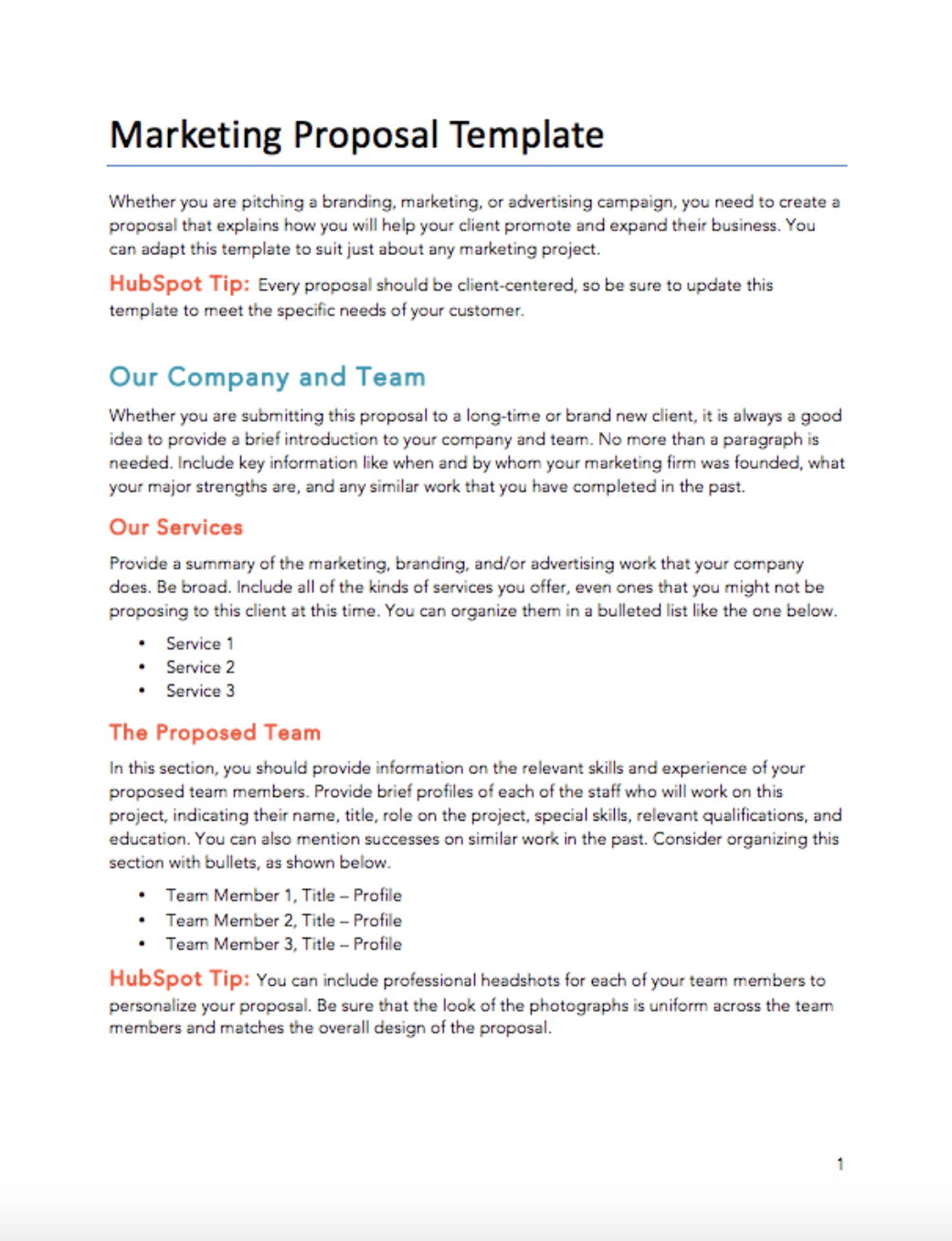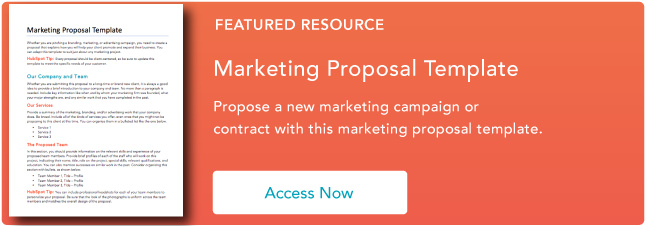It's wasteful to require your team to reinvent the process every time you need a formal marketing proposal. You can, however, approach proposal creation with a repeatable process to make things easier. Here's how:
- Qualify and uncover the needs of the client or internal stakeholder during a discovery session.
- Create a plan of action, your vision for what must be done to achieve their goals.
- Use a pre-built marketing proposal template so you can get it over to them as quickly as possible.
Marketing Proposal Tips From the Experts
Before we dive into examples, let's take a look at some marketing proposal tips from experts to help steer the creation of your marketing proposals.
“If you’re trying to create a winning proposal that stands out from the rest, it’s not enough to present great ideas. Your proposal needs to show that you understand this client’s specific goals and challenges and how your services, expertise, and platform recommendations are tied directly to alleviating those pain points.” - Brendan Walsh, Principal, Mole Street
"Every proposal your prospects will receive from your competitors will include a budget section. You need to go beyond that if you want to stand out from the crowd and avoid your prospect's decision being based solely on price. Focus on your unique value proposition; what makes your firm the perfect fit to help them face their specific challenges that you've discussed in the exploratory call? Finally, never send a proposal by email before you presented it to your lead, either in person or in a video call."-Louis Chaussé, CEO & Consultant, Auxilio
"Nothing matters until something gets sold. It's true. All the talk. All the panning. Drafts and edits of the proposal. None of it matters unless something gets sold. So what must be in a winning proposal? Three insights: 1. It's not about you. The prospect should see themselves and their objectives. Do not tell me why you matter. Tell me why I will achieve my goals. 2. Do not be boring. When you write down all the conversations, facts and insights you have shared along the journey to get to the RFP stage...you bore me. I know all that. Tell me what I need to know, that's it. 3. The RFP memorializes the proposal. Your proposal is the words out of your mouth. You should only put in an RFP what the prospect needs to memorialize from your deep conversations of agreement."- Sean Doyle, CEO and Principal, Sales and Client Strategy, FitzMartin
"Use video to walk a prospect through your proposal. Adding a walkthrough video to the beginning of your proposal adds trust and clarity for your prospect. Additionally, it will allow your proposal to stand out amongst others. Make sure to go through each section of your proposal and talk to any possible objections that may come up." - Kristopher Crockett, President & CEO, Selworthy
"In 10 years of writing marketing proposals, I've learned the hard way to only send a proposal to finalize the deal. The way your solution solves their problem should already be clear in the prospect's mind based on your discussions, with the proposal merely formalizing what you've already discussed. Even then, I'll try to have a call with the person to go through the proposal and answer their questions in real-time. Leaving someone to figure out a complex digital marketing proposal on their own leads to confusion, and hence inaction." -Damien Elsing, Founder & Director, CLCK Digital Marketing
"Remember, a proposal is typically shared internally with other stakeholders that you may not have spoken with directly. Those folks do not have all the context from your conversations. With that known, you must ensure the proposal evokes trust in your potential partnership, showcasing that you understand the prospect's business growth goals. The SOW (scope of work) deliverables need to be clear, but ultimately, the trust built from aligning on goals is what will close the deal."- Mattan Danino, Founder & CEO, WEBITMD
5 Marketing Proposal Examples
Again, the marketing agency proposal is simply the written documentation of what you have discussed in person. You should never just send over a proposal without doing a presentation of some type, whether in-person or over Skype — you have to be the one doing the selling.
However, creating a confusing proposal that's either too long or not detailed enough can work against you.
Here's are a few examples of what great marketing proposals look like.
1. HubSpot's Free Marketing Proposal for PDF & Word
2. AppSumo Marketing Proposal Template
 3. CoSchedule Marketing Proposal Template (Investment Section)
3. CoSchedule Marketing Proposal Template (Investment Section)

4. Bonsai Product Marketing Proposal Template

5. SlideTeam Marketing Proposal (One-Page Infographic)

If you're looking to learn how to write your marketing proposal template or need a refresh on your current document, use the below as guidance for putting together your proposal.
As with most things related to the sales process, every client is different and these sections may or may not apply to your prospect's need.
1. Make a good first impression on the cover page.
The cover page should simply be a visually appealing starting point for your proposal. If you're preparing the proposal for a client, you should feature their brand on the cover.
From the beginning, the proposal should show that this is about the organization and its vision. Since you'll be giving this to important stakeholders and decision-makers, make sure the cover page is aesthetic and bold.
2. Detail the findings of your discovery session with the executive summary.
The executive summary should quickly detail findings from your initial discovery session such as goals, budget, and timing.
You should also describe any research you conducted and highlight a few key points — maybe a short description of how you plan to solve their most pressing problem or how you envision taking the organization to new heights.
If this is for an agency client, this is where you'd state your desire to work with the client and detail why your agency is the right firm for the project or relationship.
In either instance, you should aim to be brief throughout your marketing proposal. The experts at Motley Fool suggest treating your executive summary as an elevator pitch. If it doesn’t grab their attention, they might not read further.
3. Outline their goals and challenges and set the stage for your solutions.
Your goal during your initial meetings or when reviewing an RFP should be to uncover the main business or marketing issues being faced. Without understanding these, you cannot connect your strategy, tactics, and anticipated results to ROI.
This section should outline the goals, plans, challenges, and timeline as discussed to reiterate their current position and to set the stage for your solutions.
Questions to ask stakeholders before the marketing proposal:
- What are your revenue goals for the upcoming quarter or year?
- What metrics are you personally measured on?
- What were your goal last year/ quarter and what did you do to achieve them?
- What resources do you have to meet your current goals?
- What challenges have prevented you from reaching your previous goals?
- What other priorities exist that might take precedence over reaching these goals?
- Would you revise the goals or the timeline if the goals were not being met?
If you're trying to close a deal as an agency, you should have also discussed the reasons the client is making the change now and what the cost to his business would be if he took no action.
Would the client miss out on a bonus or promotion? Would the business have to fire people? What’s on the line if the client fails?
This reminds the prospect of the high cost of inaction and will help them to see the cost of your services in a more reasonable way.
Remember: Nothing in the proposal should really be a surprise. It should simply be the written record of previous conversations.
4. Expand on the strategies and tactics you plan to use to reach your goals.
This would be considered either the "Deliverables" or the "Approach" section depending on the type of proposal you're creating.
Here, you'll outline how you plan to solve their problems — a high-level overview should be all that is necessary — and what services you will provide. Detailed strategies should be completed once your team has a better understanding of the business.
If this is for project-based work, you should outline the phases of the project, the responsibilities of the client, and the timeline for completion.
You can follow this structure:
Website Redesign and Development
Phase 1
- Deliverables
- Timeline
Phase 2
- Deliverables
- Timeline
For a retainer-based relationship, you should outline the various initial projects and then include the services provided per month.
It may help to outline a roadmap for the first six months if you have a process you follow with all new clients, and you should include the various upsells and what is not included in the scope of the retainer.
The below outline should be customized when creating your own proposal template:
Ramp Up Projects (Month 1 or Month 1-3)
- Initial discovery session and assessment
- Inbound marketing planning and strategy
- Editorial calendar planning
- Social media strategy planning
- Keyword research
- Competitor research
- Onsite and offsite SEO audit & planning
- Creation of buyer personas
Deliverables Per Month/Quarter
X Campaigns Per Quarter
- X blog posts
- Landing page and thank you page
- Ebook or whitepaper: writing and design
- Calls-to-action
- Email marketing launch and nurturing sequence
- Content promotion through social channels
Monthly Retainer Deliverables
- X blog posts
- Optimization projects or A/B testing
- X Ebook per quarter
- Keyword analysis
- Link building
- Email marketing: Segmentation and management of Lists
- Email newsletter
- Lead management: Score, nurture, and qualify leads
- Social media marketing: original content creation, influencer campaigns, monitoring
- Workflows and list segmentation
- Training
- Monthly reporting
Add-On Deliverables Available Outside of Retainer Fee
- PPC advertising
- Retargeting
- Sponsorships
- Guest blogging opportunities/ media relations
- Sales and marketing alignment services
- Sales enablement content
- Content promotion
- SlideShare creation and promotion
- Video production and promotion
- Ecommerce integration
- Call tracking and nurturing
- Predictive lead scoring
Each deliverable should be explained in detail, with the proposed benefit clearly outlined.
5. Provide a summary where you clearly lay out the scope of work.
If applicable, you should line-item the various deliverables and upsells and list out the feeds associated with each. This should be no more than a one-page summary that the prospect can easily reference.
6. Detail how you'll measure success in the metrics section.
Depending on how in-depth your conversations were during the qualification phase, you may have a good understanding of the current state of the decision maker’s marketing priorities.
You could include some benchmarking data, especially if this is for a website relaunch or lead generation campaign, and then highlight proposed goals for the relationship and the timeline for reaching those goals. These could include:
- Increase Visits by X%
- Increase Leads by X%
- Increase Email Subscribers by X%
- Increase Conversion Rates by X%
- Improve Sources of Leads
- Decrease Customer Acquisition Cost by X%
- Improve Email Performance
- Increase Marketing Qualified Leads
- Increase Sales Qualified Leads
7. If it's for a client, convince them that you're the right agency for the job.
The next few sections are really more for external stakeholders than internal ones.
Once you’ve established your understanding of the client’s current marketing needs and have outlined your plan, you can then establish trust and address the chemistry aspect of the relationship in the "About Us" section.
This section should be less about awards and recognition and more about what it is like working with your team. What are your values? What is your culture like? What types of things do you value in a client relationship? Give prospects a glimpse into what it is like to work with your team.
8. Provide proof of success in a case studies section.
You could also include a few relevant case studies and testimonials to showcase past successes. These should serve to reinforce your claim that you can, in fact, deliver the results using the proposed deliverables you’ve suggested.
9. Outline the terms and conditions/ contract for the relationship.
Finally, you may need to include legal language to establish the terms of your business relationship.
This should cover the rules that govern your relationship with the client, such as payment terms, a notice of cancellation, intellectual property transfer, confidentiality, data, etc. Consult a lawyer to create this document.
You may also include the final contract in the marketing agency proposal to expedite the process of starting your relationship. Once the client is ready to sign, don’t make them reach back out to you with a request for you to send the contract. Have everything they need to close the deal.
How many pages should a marketing proposal be?
After reviewing the steps involved in writing a marketing proposal, you may be wondering how long the entire proposal should be — in other words, how many pages should you be aiming for?
Well, your marketing proposal's length is bound to be unique — not every proposal should be the same length. You want your proposal to be thorough but fluff-free — there shouldn't be anything included in the proposal that doesn't need to be there.
As you may have noticed in the above section on marketing proposal examples, there are instances in which your proposal will fit on one page and others in which you need several pages. You may also choose to create a one-page version to share with certain stakeholders as well as a detailed, multi-page marketing proposal.
If you're going with a more traditional, multi-page approach, aim to keep your marketing proposal under 15 pages if possible. Many businesses say they can fit it into 10-12 pages (or even fewer!). If you need to go longer than 15 pages, try to cap your proposal at 20 pages.
Create Your Marketing Proposal Template
One of the best things you can do is create a template to work from so that the process of creating proposals is less arduous over time.
Make your own version of the template below to make it easier for your team to put together that next proposal and easier for the potential client to go ahead and sign.
Editor's note: This post was originally published in December 2015 and has been updated for comprehensiveness.
RFPs





![8 Best Tips for Business Proposal Presentations [+Examples]](https://53.fs1.hubspotusercontent-na1.net/hubfs/53/business-proposal-presentations.jpeg)

